Are high protein diets right for dogs?
There are increasing numbers of high protein diets available. However, what is the right level of protein for dogs?
When considering protein levels, it is important to not just consider the level but also:
- Balance and function of a range of nutrients - including fats and carbohydrates.
- Protein quality, especially the amino acid profile
- Sustainability of the food - animal proteins are environmentally expensive.
Understanding the Role of Protein in a Dog's Diet
A healthy adult dog with moderate activity levels needs a minimum of 18% of protein on a dry matter basis and a growing puppy needs 25% but many of the high protein diets far exceed these levels
The quality of protien is key. If you have a high quality, balanced protein then you will supply all the amino acid needs, without excessively high protein levels.
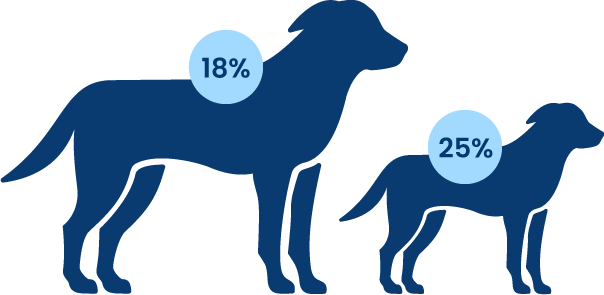
Understanding the Role of Amino Acids
Amino acids are the building blocks of proteins with different proteins having different combinations of, the 21 amino acids. There are tens of thousands of unique proteins in the body, each one of being made up from a different mix of amino acids.
Protein consumed in the diet is broken down into its amino acids. These amino acids are then put back together to make the proteins needed by the body.
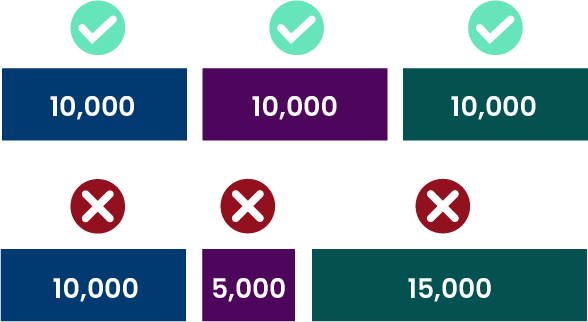
This is why it is important that the diet contains the right balanace of amino acids. Think of each amino acid as a different coloured brick. Suppose the body needed 10,000 blue bricks, 10,000 red and 10,000 yellow. However the diet eaten contained 10,000 blue, 5,000 red and 15,000 yellow. No problem with the blue amino acids. However the body would be short of red amino acids – meaning it couldn’t build all of the proteins it needed that contained red amino acids. The body would also have more yellow amino acids than it needed so would have to get rid of these – making more work for the liver and kidneys.
So the first feature of a quality protein is the balance – does it have the right mix of amino acids – neither too many nor too few of each amino acid.
The second thing that is important for protein quality is the digestibility – whether the body can break it down into its amino acids – if it can’t then the body can’t use the amino acids. The digestibility of a protein comes from the source of the protein and the way it’s cooked.
Quality not quantity
If the protein is high quality, with the right mix of amino acids, then smaller amounts can deliver all of the dogs amino acids needs. If the quality of the protein is low, with the wrong mix of amino acids, then more is needed to provide all the amino acids and that means there will be a surplus of some un-needed amino acids that need to either be used for energy or excreted.

The Role of Proteins, Fats and Carbohydrates
It is also important to consider the contribution of nutrients other than protein.
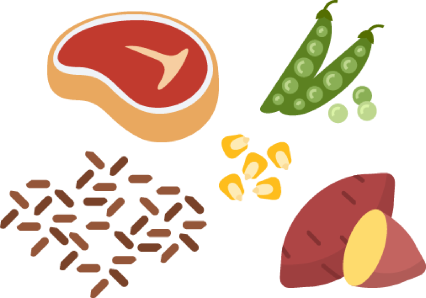
Proteins
Protein is essential for the growth, repair, and maintenance of muscles; are involved in the production of enzymes and hormones, which are involved in various physiological processes including digestion and nutrient absorption and regulkating functions such as metabolism, growth, and reproduction. Proteins also help in the production of antibodies and other immune system components, contributing to the body's ability to defend against infections and diseases. Proteins are involved in the repair and maintenance of various tissues, including skin, hair, and nails
While carbohydrates and fats are normally the primary sources of energy, proteins can provide an energy source when the reserves of carbohydrates and fats have been exhausted. However, carbohydrates and fats are far more suitable as an energy source. Its also worth noting that excess protein, not used for repair or energy, is stored as fat.
In a high protein low carbohydrate diet the protein will be providing much of the energy that could be better provided by carbohydrates and fats
Carbohydrates
The main function of carbohydrates is to provide energy. Once eaten carbohydrates are turned into glucose, which fuels the body. Any surplus is stored as glycogen and is primarily found in the liver and muscle.
Fats
Whilst carbohydrates are the main source of energy fats are also used as a backup. Fats have very high energy levels, at 9 calories per gram, more than twice the amount than from carbohydrates and protein. Fats also play an important role in the storage and absorption of vitamins.
Can dogs use carbohydrates?
At the heart of the argument for high protein diets is the idea that dogs, as ancestors of the wolf are carnivores and so require protein and fats as they are unable to use carbohydrates. This is a particularly contentious topic and one that can generate some passionate views. Wolves first started to live alongside humans from between 15,000 to 35,000 years ago. In that time, they have evolved in many ways, they are more sociable, less aggressive and an array of shapes and sizes.
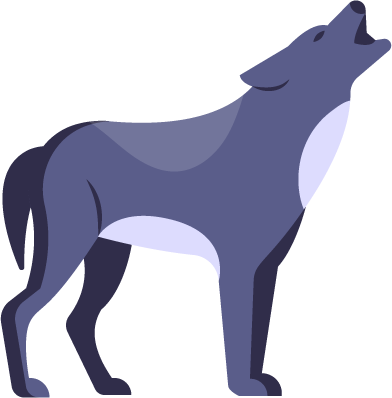
They have also evolved to be able to benefit from a wider range of foods, including those provided by humans. Firstly, there is the anatomy of the dog. They have many, large molars, which are not needed for eating meat but are used for grinding vegetable material.

They also have highly developed large intestines housing many bacteria that live off fibres and carbohydrates and not meat protein. Also, dogs, unlike wolves, produce many enzymes, in particular amylase, that breakdown starch and other carbohydrates.
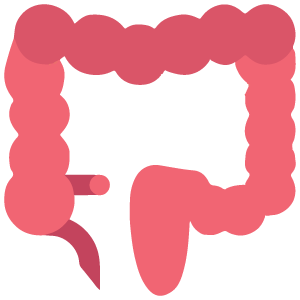
No one would argue that dogs are obligate, or true, carnivores. The definition of this being those who rely entirely on animal flesh for their nutrients, such as cats.
Dogs are either omnivores or facultative carnivore, the debate on this will continue. There is no clear dividing line between the two – but an omnivore is a species who can equally use plant and animal diets – such as humans – whilst a facultative carnivore is one who can digest plant matter but prefer animal flesh so should have a significant part of that in their diet.
However, dogs can digest and use carbohydrates – and so using them in the diet provides a valuable source of energy.
Implications of high protein dog foods
The idea that dogs need a high protein diet is not proven. Dogs can use carbohydrates for energy high quality protein will provide the amino acids needed without higher than recommended minimum protein levels.
Potential health issues from excessive protein
The question then is - is it harmful to feed high protein diets?
It is sometimes claimed that disposing of unused proteins places strain on the kidneys, but there is no evidence to suggest that this is harmful – except for in older dogs.

Sustainability of high protein diets
It is in the area of sustainability that high protein diets are the most damaging. Most diets use animal products to supply the bulk of the protein and producing animal protein is environmentally expensive, with animal-based foods producing roughly twice the emissions of plant-based ones.
According to United Nations Food and Agriculture Organization (FAO) world demand for animal-derived protein is expected to double by 2050 driven by population growth and increased per capita consumption of protein in economically developing countries. This is a major problem as livestock farming is a significant source of greenhouse gas emissions with estimates ranging from 14% to 18% of all emissions – more than is generated by transport.
In 2018 the UN Intergovernmental Panel on Climate Change (IPCC) report made several recommendations including reducing the amount of meat and dairy we consume.
Kelly Swanson in the report Nutritional Sustainability of Pet Foods highlights the negative environmental impact of the formulation of diets to provide nutrients in excess of physiological requirements.
Animal protein is environmentally expensive. We need to feed our pets properly, but should we be feeding more nutrients than are needed – particularly when they come from environmentally expensive sources such as animal protein.

